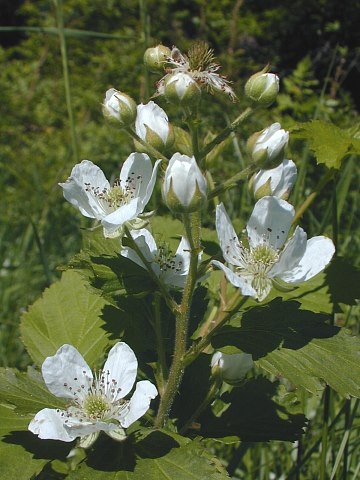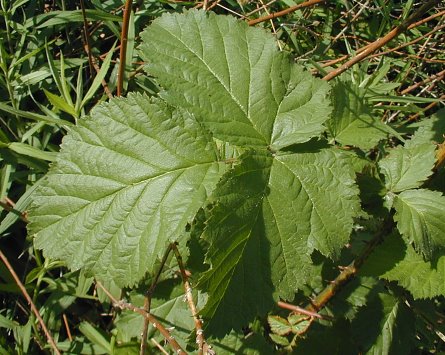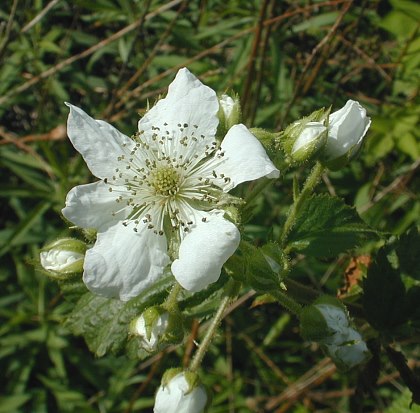Description: This woody shrub forms canes that are initially erect, but often bend downward to re-root in the ground. These canes actively grow and form leaves during the first year, and develop fruits in the form of drupes during the second year, afterwhich they die down. The canes are about 3-6' tall; they are green where there is new growth at the tips, otherwise they are brown or reddish brown with stout prickles that are straight or somewhat curved. The alternate leaves are usually trifoliate or palmately compound; they have long petioles. The leaflets are up to 4" long and 3" across; they are up to twice as long as wide. A typical leaflet is usually ovate with coarse, doubly serrate margins; it may have a few scattered white hairs on the upper surface, while the lower surface is light green and pubescent.

The canes develop
racemes with about 12 white flowers; these racemes are much longer than
they are wide. There are conspicuous glandular-tipped hairs on the
peduncles and pedicels of the inflorescence. A flower has 5 white
petals and 5 green sepals with pointed tips; this flower is about ¾-1"
across. The petals are longer than the sepals, rather rounded, and
often wrinkly. In the center of each flower, are numerous stamens with
yellow anthers surrounding a green reproductive structure with a
prickly appearance. The flowers bloom during late spring or early
summer for a month; there is little or no floral fragrance. The drupes
develop later in the summer; they are about ¾" long and 1/3" across,
although their size varies with moisture levels. The drupes are
initially white or green, but eventually turn red, finally becoming
almost black. They are seedy and have a sweet flavor when fully
ripened. The root system consists of a taproot. This plant often forms
loose colonies vegetatively.
Cultivation:
The preference is light shade to full sun, and mesic conditions; some
drought is tolerated, although this can reduce the size of the drupes.
Growth is best in rich fertile soil; a clay-loam or rocky soil is also
acceptable. This plant is easy to grow from transplants or cuttings of
young growth. It can become aggressive and be difficult to eliminate;
the use of herbicides may be required on some occasions.

Range
& Habitat: The native Common
Blackberry occurs in most counties of Illinois; it is common in most
areas of central and northern Illinois, and somewhat less common in
southern Illinois (see Distribution
Map). Habitats include moist to slightly dry prairie edges
along woodlands, thickets, open woodlands, savannas, woodland meadows,
limestone glades, fence rows, areas along roadsides and railroads, and
abandoned pastures. This plant favors disturbed, burned-over areas in
and around woodlands; it is one of the shrubby invaders of prairies.
Faunal Associations:
The nectar and pollen of the flowers attract many kinds of insects,
especially bees. This includes honeybees, bumblebees, little carpenter
bees (Ceratina spp.), cuckoo bees (Nomada spp., Coelioxys spp.),
leaf-cutting bees (Megachile spp.), mason bees (Osmia spp., Hoplitis
spp.), Halictid bees (including green metallic bees), plasterer bees
(Colletes spp.), masked bees (Hylaeus spp.), Andrenine bees, Sphecid
wasps, Eumenine wasps, ants, Syrphid flies, bee flies (Bombyliidae),
Tachinid flies, butterflies, skippers, long-horned beetles
(Cerambycidae), and scarab beetles (Robertson, 1929; Wilhelm &
Rericha, 2017; Gosling, 1986). Other insects feed on the leaves, sap,
canes, and other parts of Common Blackberry (Rubus allegheniensis) and
similar plants (Rubus spp.). These insect feeders include larvae of
metallic wood-boring beetles, larvae of long-horned beetles, leaf
beetles, plant bugs, stink bugs, aphids, leafhoppers, treehoppers,
katydids, walkingsticks, thrips, larvae of sawflies, larvae of Geometer
moths, larvae of owlet moths (Noctuidae), larvae of various
micro-moths, larvae of Tortrix moths, and larvae of a butterfly, the
Striped Hairstreak (Satyrium liparops strigosum). The Insect Table
provides a more complete list of these species. The fruits of these
woody plants (Rubus spp.) are an important source of food for many
upland gamebirds and songbirds (see the Bird Table).
Mammals also feed on the fruits, canes, leaves, and/or seeds, among
them: the Domesticated Goat (canes, leaves), White-tailed Deer (canes,
leaves), American Moose (canes, leaves), Elk (canes, leaves),
Cottontail Rabbit (canes), American Black Bear (fruits), Gray Fox
(fruits), Red Fox (fruits), Raccoon (fruits), Virginia Opossum
(fruits), Fox Squirrel (fruits), Eastern Chipmunk (fruits), Least
Chipmunk (fruits), White-footed Mouse (fruits, seeds), Woodland Jumping
Mouse (fruits, seeds), and Meadow Jumping Mouse (fruits, seeds); see
Martin et al. (1951/1961), Schneider et al. (2006), Myers et al.
(2004), Whitaker (1966), Whitaker & Mumford (1970), Hamilton
(1941), Noyce & Coy (1990), and Blackmore (1998) for more
information. Birds and mammals that eat the fruits help to spread their
seeds far and wide. Common Blackberry also provides some shelter and
shrubby protection for these various animals, and nesting habitat for
some kinds of birds. In general, the ecological value of blackberries
and similar plants to wildlife is very high.

Photographic
Location:
The photographs were taken at Meadowbrook Park in Urbana,
Illinois.
Comments:
Occasionally, blackberries (Rubus
spp.)
are found along the edges of prairies. It can be difficult to tell the
different species apart. This is one of the more common blackberries in
Illinois. The fruits of Common Blackberry tend to be a bit larger and
more elongated than those of other blackberries, and they usually have
an excellent flavor. This blackberry is distinguished from other
blackberries by the numerous glandular hairs on the peduncles and
pedicels of its elongated racemes of flowers. Furthermore, its mature
leaflets are usually no more than twice as long as they are wide. These
two characteristics distinguish the Common Blackberry
from other Rubus spp. in Illinois.